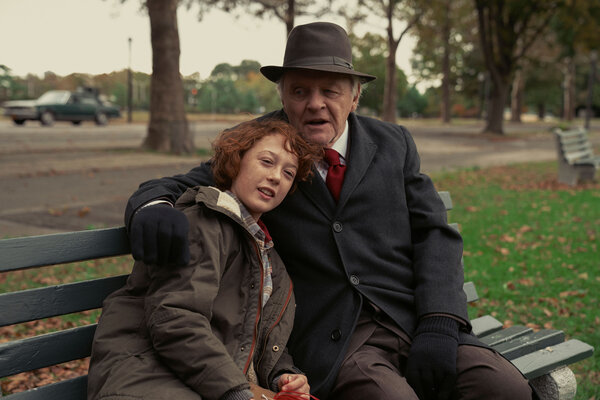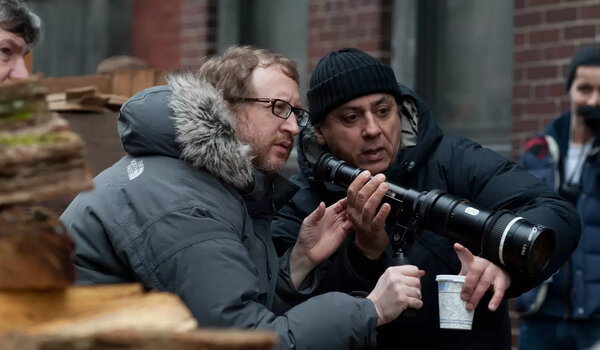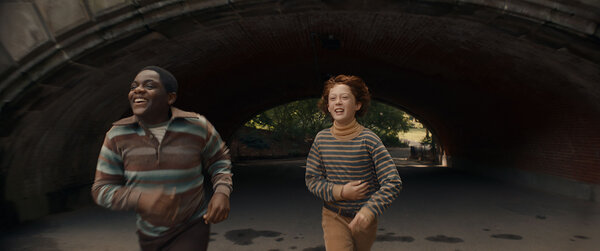Darius Khondji, AFC, ASC, discusses his work on "Armageddon Time", by James Gray
Autumn in New YorkIn the mid-1980s, the borough of Queens in New York City was under the hegemony of real estate developer Fred Trump, father of Donald Trump, future President of the United States. A teenager is enrolled at Kew-Forest School, on whose board sits Fred Trump and of which Donald Trump is an alumnus.
When asked to talk about his best memory from the film, Darius Khondji immediately evokes his joy at having been able to film such a cast : “Bringing together this fictional family in front of James Gray’s camera was a wonderful moment. For example, shooting these dinner scenes with all the actors around this young boy, which came across so realistically on the screen, it was very moving. Especially when you know that you are working on such a personal film for the director, whose memories are woven together to create its plot. The characters are all inspired by people who have since passed, and who have been resurrected the duration of a take. This is a very fundamentally dramatic aspect of the project, which was not something I expected when I first read the screenplay. There is a very nostalgic aspect to witnessing a bygone era and vanished lives. I loved it, and it immersed me in my own memories. The choice of autumn also goes in this direction, with the setting sunlight, which is for me a harbinger of death. So, it’s not for nothing that Marcel Proust immediately came to mind when I discovered the screenplay, even noting certain passages from his novel In Search of Lost Time to show them to James Gray. As for the director, he would mention keywords that served as guideposts for his film : "Loss", "Ghosts" or "It’s all gone". I would transmit these words or expressions to the crew so that we could be inspired by them even inside our tent. Gabriel Kolodny, my faithful DIT, even copied them on a piece of Permacell like a mantra taped just above his screens ! »

When asked about the references that guided the film, the director of photography mainly evokes sobriety : “Rembrandt immediately appeared in our conversations, as did a very stripped-down overhead light, which was almost religious at times. Memories of a dark house with few lights because everyone was careful to save energy during the first oil crisis. His taste for soft lighting showering the characters comes from the work of Gordon Willis on Godfather 1 and 2, of which he is a fan. “To reconcile the showering lighting and the low ceilings, I had my gaffer George Selden build very flat light boxes, made up of bicolored LED plates measuring around 40cm x 40cm and only a few centimeters thick. They were diffused using several very thick layers of magic frost, and then these devices could be installed on the ceiling to create the top lights, while being able to precisely control them in intensity and color. The 2.35 format James chose aided us even more to keep them out of the frame…”

One of the key scenes of the film is the first confession scene in young Paul’s bedroom between him and his grandfather. Darius Khondji explains : “In this film, we carefully worked on the color palettes, especially on the tones of the wallpaper. There were few bright colors, and a lot of work on the density of the walls. For example, I had all the walls shaded by several degrees of gray in this house, as in this bedroom. It was essential to be able to control the light even in the absence of the ability to hang a lot of things or a grill, as in studio. No flags, few lights... And we also didn’t adopt that digital attitude that consists in saying to oneself : “It doesn’t matter, we’ll darken this or that part during color grading”. In any case, we both had this feeling that it was necessary to give a fleeting nature to the light, to keep the image relatively uncontracted, no shines, and humble in some ways. On this film, I like to talk about "poor" light, a concept that I associate with the 1960s Italian artistic movement "Arte Povera", created by Germano Celant, who is so dear to me. If we go back to the example of this scene in the bedroom, I remember how attentive James was to this half-light, because for him, it was also his childhood memories returning, his own lighting. A very low contrast image, almost underexposed, like a brief vision that disappears… A memory. A film where we witness something in a volatile way.”

Asked about the many night scenes that punctuate the film, Darius Khondji confides : “On Armageddon Time, I wanted to use tungsten a little more on night exterior scenes, to get as close as possible to the color of the streets at that time. Here again, it was a simple lighting, with few sources and a general nocturnal brightness well below what we now know in today’s cities lit by LEDs. Also, very vertical effects, like the scene at the end of the film when the father brings his son home from the police station. I turned off most of the streetlights, leaving only a few bright spots here and there. When you’re in the car, the main effect comes from tungsten sources placed very high up, at a height similar to real streetlamps, mixed with a few ¾ counter lights coming from the lamps on entrance porches or neighboring gardens.”

Darius Khondji still adopts the working method he inherited from 35mm film, and he explains how fundamental work on set is in his eyes : “I remain very attached to ensuring the image being captured in front of us, with the actors, is respected, a bit, I’d say, the way we used to before the digital postproduction chain, where the majority of decisions are taken while shooting. In order to maintain that spirit, I have now gotten into the habit of asking Gabriel Kolodny, my DIT, to grade the images in real time while we shoot, and that these images be considered as a reference throughout the chain. The laboratory which then processes the Alexa dailies scrupulously respects the artistic direction given while shooting. In this way, and this is the strength of digital cinematography, we were able to screen the film right as it came out from Avid, with our desires for the images already perfectly integrated. Final color grading on this film (with Damien Van Der Cruysen, of Harbor in New York) was particularly faithful to the dailies concocted on set.”
Although this latest film was produced and is being distributed in theaters by Focus Features, the cinematographer is clearly regularly being recruited for series produced by and for online platforms. Asked about the expected demise of cinema in theaters, Darius Khondji replies : “It doesn’t bother me at all to shoot for platforms, quite the contrary. Be it on series or on films, they often provide a very great artistic freedom. Nonetheless, the question of whether films will continue to be released in theaters is crucial. That is exactly what happened on Okja, by Bong Joon Ho, where Netflix allowed us complete artistic freedom, and also mentioned that it would be released in theaters… which never ended up happening. I am of course a fervent defender of cinema in theaters and shooting films for the theater is what I wish to do above all. Seeing a work on a large screen, with sound that is worthy of the images and amidst other moviegoers, remains an extraordinary experience that even a home cinema system cannot imitate. So, I think filmmakers need to bang their fists on the table harder when they sign a film with a platform to demand that it actually get released theatrically. This is, for example, what Alejandro Iñárritu was able to command on Bardo, his latest film, currently in post-production, on which I was lucky enough to work with him. He was promised that the film would be released in theaters, although I’ll admit with an uncertainty as to its theatrical release in France due to French legislation on media chronology. The film should be ready by the end of the year, and I sincerely hope that everyone will be able to see it in theaters if they wish...”
(Interview by François Reumont, for the AFC, translated from French by A. Baron-Raiffe)
 En
En Fr
Fr





